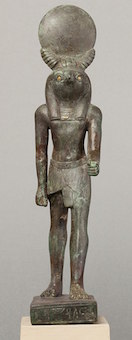In Ancient Egypt Heka (Hike) was the patron of magic and therefore also of medicine. The Egyptian word for magic was “heka” (which literally means “using the Ka”) and Heka was the personification of magic. His name (and the word magic) were depicted as a twist of flax and a pair of raised arms. The flax was often placed with the arms, and was thought to resemble two snakes. According to myth, Heka fought and conquered two serpents, and so two intertwined serpents became symbolic of his power.



He was generally considered to be the son of Menhet and Khnum and the three formed the triad of Latopolis (Esna) in Upper Egypt. He was also popular in Heliopolis where he was described as the son of Atum because of the latter’s association with Khnum.

The concept of Heka was central to the Egyptian way of life, and death. Ritual implements were used to help the deceased pass safely to the afterlife, but Heka was the means of accomplishing this task. Heka also helped Ra on his daily journey across the sky by warding off evil spirits and demons.
Although Heka had no formal worship, doctors and other healers were called “priests of Heka” and often sought his assistance. He was generally depicted as a man carrying a magic staff and a knife, the tools of a healer.

Heka occasionally appears as a falcon headed man wearing a sun disc, or as man holding two entwined serpents. In the latter case he is connected with the “caduceus” (a winged staff with two serpents wrapped around it) which is now a symbol associated with medicine.
Copyright J Hill 2010